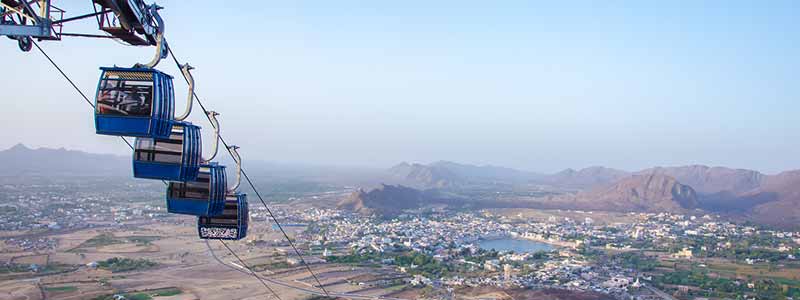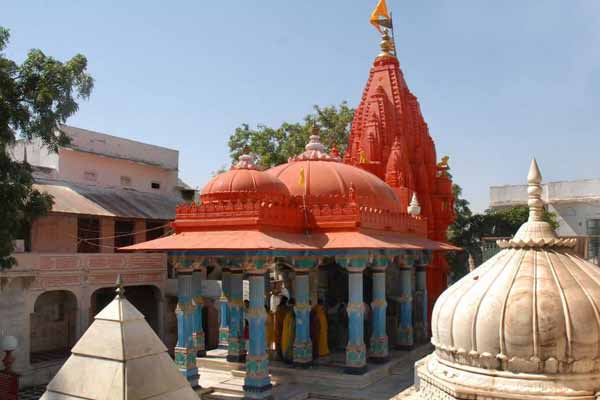Best Time To Visit Pushkar Popular for the one and only temple of Lord Brahma in India, Pushkar is a beautiful town 14 km away from another famous pilgrimage to Ajmer. The beautiful city is dotted with temples that are relatively newly built, situated on the banks of beautiful Pushkar Lake. It is assumed that in the wake of Muslim invasions that were later reconstructed, they were dissipated. The main temple here where visitors and devotees from around the nation come to visit the beautiful city is the Brahma Temple.
Speaking of Pushkar tourism, the beautiful city is known only for the Brahma Temple and Pushkar Lake. There are, however, several great places to visit, such as the Savitri Temple, which is also renowned for its high importance. Another wonderful place situated at a distance of 4 km from the lake is Old Pushkar, which is also equally venerated by the Hindus.
The beautiful city is also renowned for the world-famous Camel Fair, held every year in November. Tourists from all over the world tend to spend a day or more in Pushkar during the festival season to celebrate the holidays. Pushkar Pool, Brahma Temple, Varaha Temple, Merta Aptaeshwar Temple, Rangji Temple, Camel Safari, and a lot more are some of the wonderful tourist attractions to discover in Pushkar. In and around Pushkar, there are numerous wonderful tourist places that will definitely keep you enticed and spellbound for the time to come Best Time To Visit Pushkar.

Best Time to Visit Pushkar
Pushkar is a lovely town with hills on three sides and sandy dunes on the fourth side to trudge on. In the glistening winter sun set against the rippling, silvery waters of Pushkar Lake, the fascinating white-blue temples give an air of serenity. The best time to visit Pushkar is the winter season, when it is cool outdoors with temperatures between 8 ° C and 22 ° C.
Winter (November to February)
Tourists tend to flock into the city at the start of the winter season. During this season, the temperature varies between 8 degrees and 22 degrees C. The nights are very cool, so evening is the right time for sightseeing and exploration. This is also the Camel Fair Season. Thus, during this season, you will find several markets and stalls running. During this season, crowding is inevitable Best Time To Visit Pushkar.
Monsoon (July to September)
The Monsoon at Pushkar is not really flourishing. Similar to the summer season, the heat and humidity are very similar. The sun can only increase the temperature by sucking out heat from the sand with scorching and sporadic precipitation. With the slightest shower, moisture also rises. Thus, visiting Pushkar is one of the worst seasons. If you are a budget traveller looking for deals and offers, however, the monsoon might be the perfect time for a Pushkar holiday.
Summer (March to June)
The days are hot and dry and the nights are pretty cold. During the daytime, the temperature will rise as high as 45 degrees C. During this season, dehydration is very common among tourists. Sunburn is very popular as well. During this season, water shortages are also very popular. Avoiding summer at all costs is safer. If you intend to visit the city during the summer, Planning all your outings in the evenings. Cultural festivals, night desert walks and others are top activities to enjoy throughout summer.
7 Awesome Things to do in Pushkar
Best Time To Visit Pushkar In Rajasthan, Pushkar is a favourite travel destination, as it happens to be a temple town. Curling around Pushkar Lake, which is a sacred site said to have legendarily appeared when Lord Brahma dropped a lotus on the site, has grown in the town of Pushkar. It is an ancient city that is considered to be the preferred place to worship Brahma.
Pushkar is located on the shore of Pushkar Lake And here, as they were the wives of Lord Brahma, the deities Savitri and Gayatri are commonly worshipped. An experience from your tour provides you with a holiday guide to Pushkar. Since it is a temple town, the most important temples of Lord Brahma, Savitri and Gayatri Devi are visited. The camel fair, held in November, is another major tourist attraction in Pushkar. There are a variety of hotels with rooftop restaurants overlooking Pushkar Lake for a serene view as you dine. The city has no alcohol and only minimal vegetarian consumption.
Brahma Temple
One of the biggest and most prominent temples in Pushkar is the Jagatpita Brahma Mandir. It is also the only temple dedicated to the creation of Lord Brahma or the Lord. Make sure to include this temple in your list of Pushkar places to visit. It is said that the temple was built in the 14th century AD and was restored again later on. The temple is marked by a red spire and at the entrance there is a motif of a hamsa eagle. The temple’s floors and walls are marked with carvings dedicated to the dead. We suggest you visit the temple during the special prayer service for a special experience Best Time To Visit Pushkar.
Savitri Mata Temple
Savitri Mata Temple, a famous pilgrimage to Pushkar, is a Hindu temple dedicated to Goddess Savitri. The temple houses the idols of Lord Brahma, Savitri the Goddess, and Gayatri the Goddess, all of whom are Brahma’s consorts. There is a ropeway ride that leads to the Temple of Savitri Mata, so getting to the top is easy. Others who want to take the long way up can hike through Ratnagiri Hill to the temple. You can enjoy lovely views of the lake and Pushkar’s skyline from the temple complex.
Old Rangji Temple
Rangji Temple, situated in Chotti Basti near Pushkar Lake, is a fine example of South Indian architecture. Sculptures of Hindu gods and people adorn the walls of the temple. The temple is dedicated to Lord Ranga, the personification of Lord Vishnu. There are also small arches with decorative inscriptions throughout the temple. On the temple grounds, there is also a stupa. Do not forget to include this temple in your list of Pushkar’s top places to visit!
Varaha Temple
A large crowd is drawn to the Varaha Temple since it is situated near the Pushkar bus stop. In Pushkar, it is one of the largest and most important temples. The image of Varaha, the third incarnation of Lord Vishnu, can be found inside the temple. Along with being dedicated to Varaha, the temple is also renowned for its beautiful architecture. It is assumed that the temple was built in the 12th century and the Mughals demolished it after it was restored in the 18th century.
Pushkar Lake
Pushkar Lake, a must-visit spot for all visitors, is a scenic beauty located in the heart of the region. Near the pool, there are about 52 bathing ghats that thousands of devotees visit when visiting the city for a walk. Locals, as well as devotees from across the country, during the holy occasion of Kartik Poornima, To take a holy dip in Pushkar Lake, visit Pushkar and also attend the Pushkar Fair, which is organised around this time. There are many temples surrounding the lake that are worth visiting if you are seeking peace and quiet or love Indian architecture.
Varah Ghat
One of the 52 ghats close to Pushkar Lake is the Varaha Ghat. It is believed that in his third incarnation, the Varaha or boar to ward off evil spirits, Lord Vishnu appeared in this ghat and the ghat thus got its name. The best time to visit the Ghat is when the Aarti is conducted in the evening. It is a special and serene experience and very distinct from what you may have seen in Haridwar and Varanasi in Ganga Aarti.
Gandhi Ghat
Gandhi Ghat definitely features in Pushkar as one of the best places to visit. This ghat is where the holy ashes of Mahatma Gandhi, our Father of the Country, were sprinkled. This is the most famous ghat in Pushkar, following the Varah Ghat. To watch the sunset, visit the ghat in the evening. Previously, this ghat was called the Gau Ghat.
